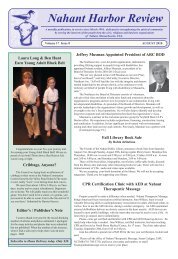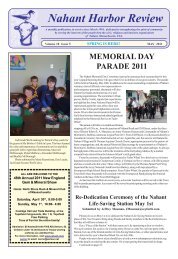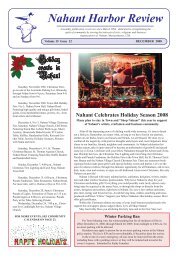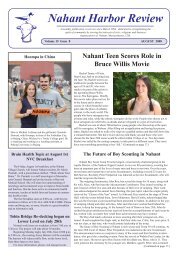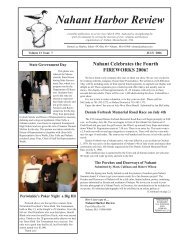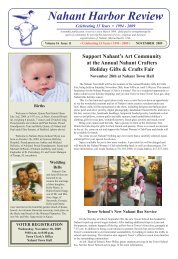Nahant Harbor Review - Nahant, Massachusetts USA
Nahant Harbor Review - Nahant, Massachusetts USA
Nahant Harbor Review - Nahant, Massachusetts USA
Create successful ePaper yourself
Turn your PDF publications into a flip-book with our unique Google optimized e-Paper software.
NAHANT HARBOR REVIEW • JULY 2009 • Page 9<br />
You Inspire Me<br />
By Susan Cadigan, LMT, MLD/CDT, NCTMB, <strong>Nahant</strong> Therapeutic Massage<br />
Often, when one is required to hold a certain posture, or do repetitive tasks, the body will develop postural distortions and pain patterns. Over<br />
time, the muscles and tissue can develop very tender knots, mixed within very tight muscles. These areas can create pain directly where the knot is, or<br />
the knot may refer them to other locations. These knots and tight areas are often referred to as trigger points and myofascially restricted areas. Over<br />
use and repetitive tasks may be the obvious way that trigger points and fascia problems occur, but not so obvious ways can be from trying to get into<br />
shape with “too much, too soon”, awkward sleeping positions, walking the dog, to name a few. Pain, from trigger points, can be quite intense. The<br />
sensations are not always pain, but can be tingling, hypersensitivity, a burning feeling (often between the shoulder blades), stiffness, aches and reduced<br />
range of motion. Often we can have many long-term body aches, years after an auto accident. This may be due to trigger points in the chronic stage, or<br />
fascia that has been injured. Headaches and pain in the forehead, or back of the neck, can be the result of these knots in the trapezius (“shoulder”)<br />
muscles. It is very important to have your headaches checked by your primary care doctor, to rule out important health issues. If he, or she, comes to<br />
the conclusion that it may be stress, or due to an imbalance of muscle, from the demands of work, or can find nothing wrong, then addressing your<br />
discomfort with bodywork will be appropriate.<br />
The trigger points and myofascially-restricted areas don’t often respond to gentle, superficial warming, or rubbing. It may feel better, but the<br />
source may remain. This is where the myofascial mobilization and neuromuscular techniques (Trigger Point) can truly make a difference. For the<br />
“team work” approach, one would wear shorts and a sports bra, or bathing suit top at times. Men do not need to adhere to the sports bra/bathing suit<br />
top, during sessions. We work as a team to remedy the situation. This does require your feedback to the level of intensity, when I hold onto the knot.<br />
or lengthen the area with my hands, knuckles, or forearms. I work the area as fast (or slow) as the tissue is willing to move. I follow the tissue’s lead,<br />
with a gentle nudge in the right direction. It may be gentle, but there will be times that you will feel some discomfort, but it results in relief. Often, it is<br />
described as “good pain.” It may take more than one session to remedy the situation. Your compliance to breaking the patterns, that created discomfort,<br />
and some lengthening and/or strengthening, will play an integral part in alleviating the issue at hand. Team work should result in longer periods of<br />
freedom from the distraction of pain, or discomfort.<br />
I have honed my practice to get to root of the root problems that are presented to me. With your trust and support, by your visits, I continue to<br />
endeavor to be the best I can be for you. Thank you for inspiring me.<br />
Susan Cadigan is licensed and nationally certified in therapeutic massage and bodywork. She holds a diploma in Advanced Massage Therapy, is<br />
certified in Advanced Myofascial Mobilization and has many hours of continuing education and experience, and other certifications. <strong>Nahant</strong> Therapeutic<br />
Massage is located at 41 Valley Road, the <strong>Nahant</strong> Community Center. For more information, or to schedule an appointment, please visit;<br />
www.nahantmassage.com, or call 617-240-4252.<br />
Q. My doctor measures my height every year and I am<br />
shrinking in height, why does this happen?<br />
A. Your spine changes over time, creating a loss in height. These degenerative<br />
changes occur as part of the normal aging process and may begin during your 20’s or<br />
30’s. The spine is made of a column of vertebral bones and a disc that lies between each<br />
vertebrae. The spine has three normal curves. The spinal canal runs through the lumbar<br />
vertebrae and contains the nerves supplying sensation and strength to the legs. Arthritis<br />
may form in and around the facet joints, which are part of the vertebrae. With aging, the<br />
bones that make up the vertebral column begin to model, or change, in size or shape.<br />
Sitting in a slouched position, working in sitting with a rounded upper back, lifting<br />
objects repetitively, without bending your legs, or standing in a bent position, are examples<br />
of poor postural habits, which contribute to the aging process. Over a prolonged<br />
period of time, the spine begins to change shape from lack of muscle support, and the<br />
discs become less spongy fluid-filled. The vertebrae and disc go through the aging process<br />
and the curves change causing loss of height.<br />
There are four phases of spinal degeneration. During phase 1, there may be some<br />
loss of height and changes in the normal spinal curves. During phase II, disc-narrowing<br />
and bone spurs may occur. Postural changes become more evident and spinal canal<br />
narrowing (stenosis) may occur. This phase may be characterized by aches, pains and<br />
fatigue. Height continues to decrease. Phase III can be characterized by significant<br />
postural changes, scar tissue formation, bone deformation and possibly physical weakness.<br />
During the fourth and most advanced phase, there may be nerve damage due to the<br />
vertebrae shifting and spurring occurring from arthritic changes.<br />
Even though spinal degeneration begins to occur as part of the normal aging process<br />
this does not mean everyone goes through all the phases or has severe postural changes.<br />
Strengthening the back and abdominal muscles is very important for keeping your spine<br />
upright. Postural changes in the spine resulting from poor sitting or standing habits may<br />
lead to adaptive changes in the muscles that support the spine and may influence the<br />
curve formation of the spine. Remember to sit and stand upright, keep active, and<br />
strengthen your back and abdominal muscles.<br />
If you are experiencing back pain, or if you want to learn more about strengthening<br />
your postural muscles, please discuss your concerns with your doctor and consider a<br />
course of physical therapy treatment. Please contact North Shore Physical Therapy in<br />
Marblehead, 781-631-8250, or in Swampscott call 781-592-2773.<br />
To advertise in this paper, call 781-592-4148, or email donna @nahant.com.<br />
Please help support <strong>Nahant</strong> Home Delivery.<br />
Please send in your subscription or donation, in the<br />
2009 Subscription Envelope, enclosed with this issue.<br />
Help us keep the <strong>Review</strong> coming to you!<br />
PRIVATE MUSIC LESSONS<br />
WIM<br />
NAHANT SUMMER SCHOOL<br />
~~~~~~~~~~~~~~~~~~~<br />
Swim Lessons for Children<br />
Ages 4-16<br />
June 29th thru<br />
August 6th<br />
5 weeks<br />
with KELLY RILEY<br />
Voice, Piano, Guitar, Bass<br />
All Ages / All Levels<br />
Experienced, Patient Teacher,<br />
Berklee Alum, Pro Musician<br />
617.699.6243<br />
Directed by Former Harvard Swim Coach<br />
Maura Costin Scalise<br />
For Information, Call:<br />
(781) 599-8614



